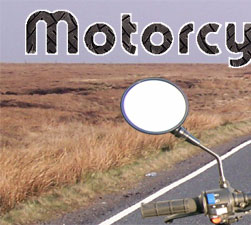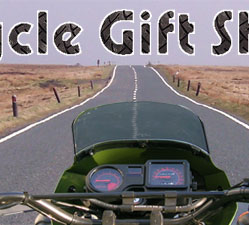 |
|

|
Aside from the standard wrenches and screwdrivers, there are a few specialized tools made specifically for working on motorcycles. Though you can usually make do with what you have, having the right tool for the job always make it faster, easier and reducing the chances of damaging something.
- Motorcycle Jack - If you motorcycle comes stock with a center stand, a jack usually not necessary. Many bikes today rely on side stands so there is no quick and easy way to get the wheels off the ground for easier maintenance (Off-road and dual sport motorcycles rarely have center stands because they have a tendency to get snagged on rough terrain). Allowing the rear wheel to spin freely is necessary to clean and lubricate the motorcycle's drive chain. Motorcycle jacks slide under the frame and lift the bike hydraulically. Motorcycle jacks usually range from $50 to $200. If you plan on working on your bike often, it is probably a good investment. The most frequent use for the jack is to raise the motorcycle's rear wheel.
- Rear Wheel Stand - An alternative to using a motorcycle jack is to get a rear wheel stand. Basically, these stands are designed raise the rear wheel only instead of lifting the entire vehicle. No hydraulics are involved with these stands, they just use basic leverage to boost the rear of the motorcycle. They are lighter and more compact than motorcycle jacks but costs as much as, if not more, than a value priced jack. Personally, I opted for the greater functionality of a motorcycle jack.
- Tie Downs - Ratcheting tie downs are not inherently motorcycle related but they can be very useful for stabilizing and securing a motorcycle while it is on a jack. Ratcheting tie downs are critical for strapping a motorcycle down for transport…not that you would ever want to trailer your bike when you could be riding it.
- Cable Lubricator - Most motorcycles rely heavily on cables to actuate the different controls. You should lubricate your cables regularly to make sure you get the most life out of your motorcycle's cables and, more importantly, that they don't stick while you are riding your bike. To lubricate your cables effectively, you need a pretty simple tool that clamps onto the end of the cable's sheath. The lubricator has a small hole that accepts the snorkel from the pressurized can of cable lube. It is not entirely foolproof and I would suggest keeping a rag near by to clean up any spray. Overall, it is an efficient way of lubricating the clutch, choke, throttle and brake cables on your motorcycle. It's inexpensive as well with a cost of maybe $15 for the tool and a can of cable lube. That is certainly cheaper than replacing even a single cable.
- Chain Lube - If you motorcycle is chain driven it is very important to regularly clean and lubricate your chain. The drive chain and sprockets (usually pretty pricey items) will wear out very quickly if this maintenance task is neglected. There are specially made cleaning solvents (if you have o-rings in your chain, make sure you are using something that is o-ring safe) but most people will use a rag soaked in kerosene. Though you can use regular heavy weight oil on your chain, regular oil has a knack for flinging off at the RPMs your chain experiences. I prefer to go with a can of spray chain lube. It makes the job quick and easy and the chain lube adheres to the chain very well. It looks a lot like lithium grease but I can't say for sure if that is what it is made up of.
- Ramps - OK, so ramps aren't exactly "tools" per se and they are not totally necessary for most applications. Still, they can come in handy from time to time, especially if you have a dirt bike that you want to load into the back of a pickup truck. A good ramp is normally made of aluminum so they are strong but keep the weight down. Some fold so they can be tucked away easier when they aren't in use. They are usually the safest way to get a motorcycle from a low surface to a higher surface. I store my motorcycle in a tool shed that is raised a little over half a foot off the ground. I normally use a piece of plywood and a log as a ramp and it gets the job done. It isn't always super stable and the bike has tried to pin me against the wall of the tool shed a couple of times so if you want to be safe, ramps are probably a better solution.
- Pressure Gauge - A tire inflation gauge is a
must have tool if you own anything that rolls on inflatable
tires. Cars, motorcycles, ATV and even bicycles require
the proper air pressure to operate as efficiently and
as safely as possible. When on the road, keeping tires
inflated to manufacturer's specifications will increase
the life of the tires and maintain stability and control.
If you take your motorcycle off-road, it is usually a
good idea to lower the tire pressure to maximize traction
on dirt, sand or gravel. No matter where you ride, you
need to check your tires early and often. A pressure gauge
is one of the cheapest motorcycle tools you'll come across.
- Motorcycle Wheel Chocks - Motorcycle wheel chocks
are usually designed to stabilize the front or rear wheel
of a bike. They usually mount to the floor of a trailer,
truckbed or garage to securely hold the motorcycle in
an upright position. Some models lock the wheel in, other
simply offer support. If you need to save space in your
garage, using a wheel chock can help save space over a
conventional side stand. If you frequently move your motorcycle
by truck or trailer, wheel chocks are a great investment.
A combination of wheel chocks and tie downs is the most
reliable way of securing a motorcycle for transport.
- Battery Trickle Charger - Trickle chargers can
be very useful if you live in an area with harsh winters
where your motorycle might sit for an extended period
of time. If a motorcycle sits idle, the battery will slowly
discharge on its own. Cold weather exacerbate the problem
and cause the battery to drain faster. A good trickle
charger will monitor the battery levels and only push
current through when the battery needs it. When you're
ready to ride, you can trust that your battery will have
plenty of juice to get your motorcycle fired up right
away.
|
| |
|
|
 |






